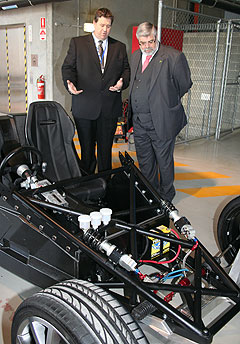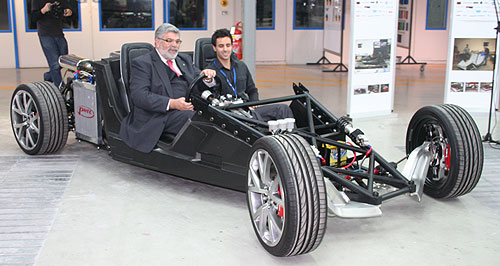Make / Model Search
News - General NewsAussie carbon concept bound for FrankfurtShowcase: Senator Kim Carr gets behind the wheel of the FR-1 roadster with chief engineer for the project, Russell Gallagher. AutoHorizon Foundation’s FR-1 roadster set to showcase Aussie composites4 May 2011 A CONCEPT car being built in a unique collaboration between business, students, government and volunteers will showcase cutting-edge Australian technologies to global automotive manufacturers at the Frankfurt motor show in September – if the not-for-profit AutoHorizon Foundation can raise the funds to finish the car in time. The two-seat FR-1 roadster boasts a light-weight passenger cell made of carbon fibre cured at low temperatures in a process that the government-funded Victorian Centre for Advanced Materials Manufacturing (VCAMM) – a partner in the project – says costs just 11 per cent of a standard high-heat composite system baked in an autoclave. AutoHorizon CEO Brian Tanti said a composite component costing $1800 using the traditional high-heat process would cost just $200 in the cool-cure system, bringing composites in reach of car-makers and other industries needing lightweight but strong construction. “It paves the way for significantly low-cost carbon-fibre mass-production automotive body panels,” he said. While the carbon-fibre-reinforced plastic ‘tub’ and mechanicals are complete, the Melbourne-based AutoHorizon Foundation needs up to $500,000 to put the finishing touches to the car, which has been in development for nine years with the help of companies such as Holden – whose designers penned the body – and Boeing, which helped with the carbon-fibre curing process.  Left to right: VCAMM chief executive Brad Dunstan with federal innovation and industry minister Senator Kim Carr. Left to right: VCAMM chief executive Brad Dunstan with federal innovation and industry minister Senator Kim Carr.Designed to showcase the latest automotive technologies available in Australia and stimulate student interest in automotive careers, the FR-1 has been built by professional designers, engineers and technicians working alongside secondary and tertiary students working. AutoHorizon today invited federal innovation and industry minister Senator Kim Carr to drive the rolling chassis of the Holden V8-powered, mid-engined speedster for a few metres for the cameras at the Automotive Centre of Excellence where the project is based. AutoHorizon is hoping the federal government might find funds to help complete the FR-1, which ultimately will be auctioned for charity – hence its name, Fund Raiser 1. Apart from the Frankfurt show, the team building the car also hopes to display it at the giant SEMA (Specialty Equipment Marketing Association) automotive trade show in Las Vegas in November if the money to complete the outer aluminium shell and other finishing touches is forthcoming. The foundation had hoped to make the 2010 SEMA show with the FR-1, but delays in the completion of the car forced a postponement to this year’s show, along with Frankfurt. Chief engineer for the FR-1 project, Russell Gallagher – whose day job is with VCAMM – said the FR-1’s rolling chassis, complete with its 6.0-litre V8 Holden engine and Ferrari rear-mounted gearbox and clutch, weighed just 500kg. He said that when completed, with its aluminium body and fittings, the car is expected to weigh 900kg. That’s about 40kg lighter than a similarly powered Elfin Clubman which is built on a steel space-frame. Mr Gallagher said he had drawn inspiration for many aspects of the FR-1 design from the large collection of exotic cars in trucking magnate Lindsay Fox’s collection at Docklands, next door to the Centre for Automotive Excellence. He said that at 3100mm, the FR-1 had the same wheelbase as a Ferrari F50 – not coincidentally – and longer than that of a Holden Commodore. Mr Gallagher said materials for the carbon-fibre passenger cell were supplied by Dandenong-based DSM Composites, and cured by aerospace specialist Boeing in Port Melbourne. According to DSM Composites sales manager Adam Heath, the epoxy resin impregnated into the carbon-fibre material contained an accelerant that helped the composite to cure at 70 degrees, instead of 200 degrees in an autoclave. He said the low-temperature curing led to less shrinkage. VCAMM chief executive Brad Dunstan said the technology used in the FR-1 not only saved energy in the curing process but, due to its lighter weight, would help vehicle manufacturers make more fuel-efficient vehicles. “The quality of the carbon fibre and the design work done in this car is world class,” he said. “We will take this car globally in the next 12 months to show it world wide, to show this is what Australia can do, not only for carbon fibre, but for advanced manufacturing and advanced materials.” Holden chairman and managing director Mike Devereux and design director Tony Stolfo were among the interested observers at today’s reveal, with both saying that composite construction was of great interest to the company as a way of ‘light-weighting’ its cars. Mr Devereux said Australia was playing a leadership role in pure automotive engineering and design research, which he said should be nurtured.  Read more |
Click to shareGeneral News articlesResearch General News Motor industry news |










Facebook Twitter Instagram